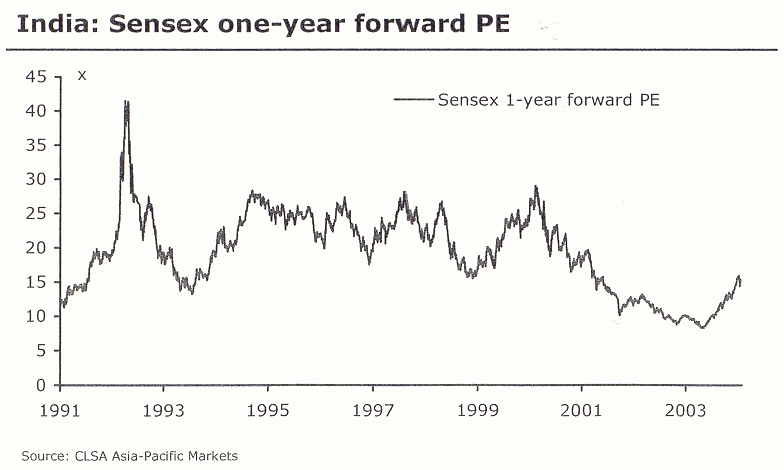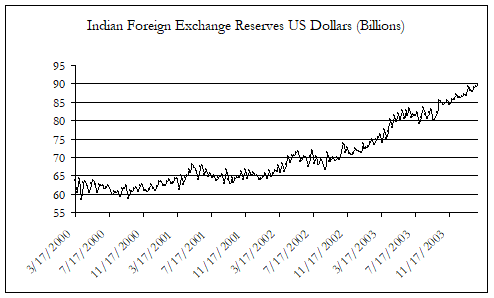Equinox Partners, L.P. - Q4 2003 Letter
Dear Partners and Friends,
Equinox in 2003
Over the past year, our self-described contrarian long investments have begun to take on a slightly more conventional hue. The ownership of resource businesses can finally be advocated in polite company without eliciting scorn, which is not to say that these sectors are widely held. Energy stocks currently account for less than eight percent of the S&P 500, a gross under-representation, and the all gold mining stocks in the world still have an aggregate market cap smaller than Microsoft's.
We are benefiting as the company specific merits of our investments (low PEs and high ROEs) are increasingly outweighing a priori investing prejudices (gold is a barbaric relic and overseas investing is excessively risky). Today’s slightly less dogmatic environment is playing to our strength as stockpickers, a welcome change to which we are rapidly acclimating.
We always understood that wider ownership of our formerly lonely investment themes was inevitable. As one observer described the ownership life cycle of a successful investment idea, "first there are the innovators, then the imitators, finally followed by the swarming incompetents." Of all of our investment themes that have contributed to Equinox Partners’ superior performance in recent years, Asia is most quickly working its way through the "innovator, imitator, incompetent" progression. But even in Asia, we are still just in the beginning stages of this sequence thanks to the combination of the extremely low valuations from which Asia began this bull market as well as the improving company fundamentals that are almost keeping a pace with the region’s rising stock prices. To emphasize this last point, we've decided to spend the remainder of this letter focusing on an important new component of our Asia strategy, India. While India is undeniably beginning to attract some “imitators,” many of the best businesses there remain significantly undervalued.
India
"The dominance of the US is already over. There's no center in this world economy. India is becoming a powerhouse very fast. The medical school in New Delhi is now perhaps the best in the world. A technical graduate of the Institute of Technology in Bangalore are as good as any in the world. Also, India has 150 million people or whom English is their main language. So, India is indeed becoming a knowledge center." Peter Drucker, Fortune January 12, 2004
We have recently returned from a two week sojourn to India to reconnoiter new investment ideas. Despite the dramatic appreciation of Indian stocks last year, we returned very enthusiastic about the investment prospects we saw there. The source of our enthusiasm is an unusual one for skeptics like us: we are persuaded that many of the Indian companies we saw are on the threshold of a period of sustained organic profit growth. Furthermore, the high single digit multiple of earnings on which many of these companies trade seriously undervalues their strong future earnings' growth and capital allocation discipline.
Most of the outstanding businesses we visited in India are benefiting from a double digit growth in disposable income that is a function of India's accelerating economy. From personal accessories to residential mortgages, India's burgeoning middle class is increasing its consumption in concert with its rapidly growing income. Sensible government policies and falling domestic interest rates bear much of the responsibility for the unbinding of the Indian consumer:
"The housing boom captures most elements of the Indian growth story-rising consumer aspirations (to have an owned house, rather than a rented one), enhanced affordability due to lower interest rates, and a change in government policy (tax breaks) towards consumers. The equated monthly installment (EMI) payable (net of tax breaks) on a Rs100,000 house loan has fallen from Rs1,570 to Rs681 over the past seven years, when incomes have risen by 84%." CLSA Report The Paradox .January 2004
With the penetration rate in the residential mortgage market still all of 1%, it's no wonder that our financial holdings in India are consistently growing their mortgage assets at 25-30% per year. Importantly, the high ROEs of several of these companies allows them to fully fund growth with internally generated cash flow while still devoting considerable excess cash flow to dividends, share buybacks, acquisitions and new business opportunities.
India's currency, like most Asian currencies, adds the final positive dimension to this investment story. The Indian Rupee's significant under-valuation is readily apparent to the tourist visiting the country, an observation which official estimates of purchasing power parity corroborate. The cause of the undervaluation- the Indian authorities are actively managing the Rupee/Dollar rate to restrain Rupee appreciation (n.b. India’s rapidly growing foreign exchange reserves). Like China, India's growing dominance of numerous global industries reflects the country's growing abilities as well as the substantial undervaluation of its currency. Eventually, when the Rupee/Dollar market equilibrium is re-established, Equinox should profit further.
Conclusion
We have taken advantage of the recent run up in the NASDAQ to meaningfully increasing our short exposure to several overvalued deteriorating businesses. Barry Diller’s blunt appraisal of the present state of affairs in America mirrors our own sentiments perfectly:
"We are on our way into a new bubble and bubbles eventually get pricked. This growth will also produce an endless number of brainless ideas, short-term greed, ridiculous valuations, investor speculation and all the other lovely horrors we have so quickly forgotten." Barry Diller, CEO of Interactive Corp.
Sincerely,
Sean Fieler
William W. Strong











